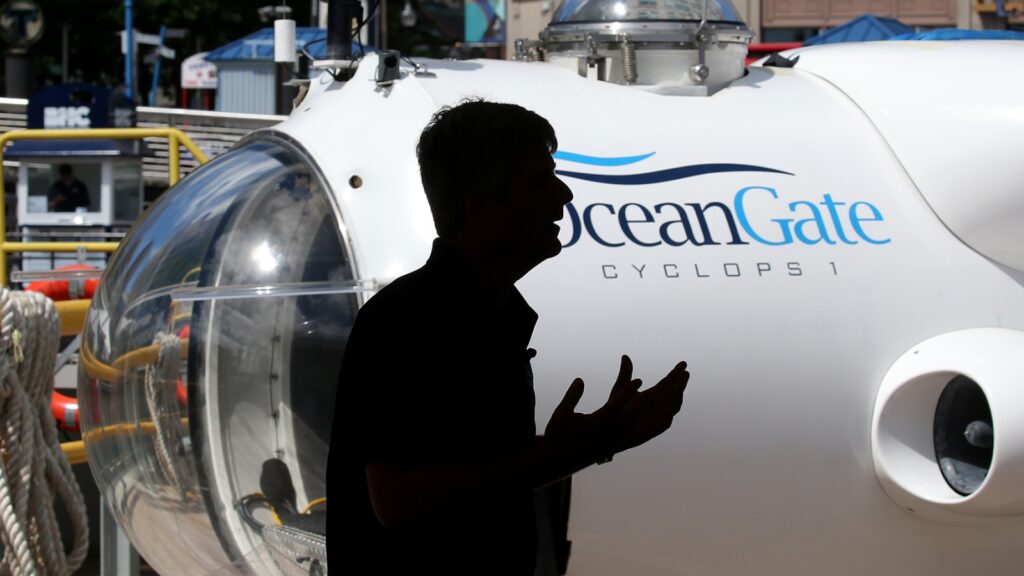
Inside OceanGate’s Doomed Titanic Dive: Flouted Regulations and Murky Finances
First Stockton Rush wanted to be an astronaut, but couldn’t, because of poor eyesight. So, he tried working as a flight-test engineer. Then he went to business school. Then he traveled to the Mojave.
It was in that vast desert, after watching the launch of SpaceShipOne, the first crewed private spaceflight, that Rush realized what he truly wanted: “I wanted to explore,” he told Smithsonian Magazine, an origin story that lead to an Icarian venture that, in the end, proved fatal.
Rush’s craving to explore led him to start OceanGate, marketed as an innovative step forward — a SpaceX for the seas, if you will. Rush wasn’t an expert in the sea — in fact, he was put off by the “vast amounts of paraphernalia” in scuba diving.
His eyesight might have failed him. The trappings of scuba diving might have annoyed him. But he wanted to explore. So, for Rush, the scion of a wealthy family in oil and shipping and the descendant of America’s powerful, money was the answer.
And so, OceanGate, his solution, was always going to be a business venture, one that made strange bedfellows out of the purity of curiosity in the natural world and the urge to plunder it. It was a clash of ambition that ended in darkness, both in the depths of the Atlantic and back on land, with OceanGate wiping its website and going silent in the aftermath.
Last Thursday, following a frantic, wide-reaching, dayslong search, the U.S. Coast Guard confirmed that the OceanGate submersible had succumbed to a “catastrophic implosion” near the site of the Titanic shipwreck at the bottom of the Atlantic Ocean. Presumed dead were the five on board, including 19-year-old Suleman Dawood and his father, British-Pakistani businessman Shahzada Dawood; Paul-Henri Nargeolet, a French maritime expert; Hamish Harding, a British businessman and explorer; and Rush himself, who was piloting the vessel.
Stockton Rush’s OceanGate is a privately-owned company “focused on increasing access to the deep ocean through innovation of the next generation of crewed submersibles and launch platforms,” according to an archived version of the company’s now-wiped website. The company has completed over 14 expeditions and over 200 dives in the Pacific, Atlantic, and Gulf of Mexico, according to the archived webpage.
“If you think about the earth as really the landmass that we all occupy, then there are three planets’ worth of resources available in the ocean,” Rush said in an OceanGate video from early 2015. “Minerals, chemicals, biologicals — it is a vast, huge opportunity.”
It was, it seems, that opportunity that made deep-sea exploration so appealing. “If a technology doesn’t have a commercial or military application, it doesn’t tend to get adopted,” Rush said in an April 2017 presentation to the Explorer’s Club in New York, a “multidisciplinary, professional society dedicated to the advancement of field research, scientific exploration and resource conservation,” according to the organization’s website.
In the 2019 Smithsonian Magazine feature, he went even further: “We’re going to colonize the ocean long before we colonize space.”
Rush started that private enterprise with co-founder Guillermo Söhnlein in 2009. The two had met through aerospace engineer and sub designer Graham Hawkes the year prior, and bonded over the fact that they’d both wanted to be astronauts but couldn’t because of their eyesight.
“We’d both had Captain Kirk and Jacques Cousteau,” Söhnlein tells Rolling Stone. “We talked about how going underwater was the closest we could get without leaving Earth.”
Söhnlein, who left the company in 2013 but still owns a minority share, explains that, at that point, sea exploration was only accessible through government-owned vessels. “If you were a researcher and had to explore the ocean, you had to get into one of the government’s subs,” Söhnlein says.
“The only way that humans were able to go down to the deep ocean back then was by either going in one of the government vessels. Your only other option was to pay to build one.”
Söhnlein says OceanGate set out to find a new solution, one that involved using private capital to build vessels, and creating a system that would allow people to charter them. That way, OceanGate would circumvent the bureaucracy they so decried to create a new “paradigm” — one that would allow innovators to reach the depths of the unexplored seas.
“We wanted to show the world it was possible to go down to 4,000 meters,” Söhnlein says. “I believe Stockton realized the best way to do that was to prove it ourselves.”
‘You’re remembered for the rules you break’
Governmental bureaucracy was OceanGate’s bogeyman from the very beginning. Extensive reporting has borne out Rush’s prickly response to criticism and concerns about safety and illustrated a stubborn commitment to innovation and innovation alone.
“By definition, innovation is outside of an already accepted system,” the company said in a 2019 blog post on the OceanGate website. “This does not mean that OceanGate does meet standards where they apply, but it does mean that innovation often falls outside of the existing industry paradigm.”
“There hasn’t been an injury in the commercial sub industry in over 35 years,” Rush said in the Smithsonian feature. “It’s obscenely safe, because they have all these regulations. But it also hasn’t innovated or grown — because they have all these regulations.”
In a 2021 interview with vlogger Alan Estrada, Rush discussed his vision with a childlike eagerness.
“I’d like to be remembered as an innovator,” Rush said. “I think it was General MacArthur who said, “You’re remembered for the rules you break. And, you know, I’ve broken some rules to make this.”
And if there is any place to test the waters of rule-breaking innovation, it would be the ocean.
“The bulk of the world’s oceans is called the high seas,” said University of Washington law professor and maritime law expert Thomas Schoenbaum. “And the high seas are outside the jurisdiction of any country and outside the jurisdiction of anything, besides, well, God.”
‘100-Percent Insiders’
At the time of the submersible implosion, there were three OceanGate-associated entities: the company’s headquarters based in Everett, Washington; a subsidiary based in the Bahamas; and a separate nonprofit, the OceanGate Foundation.
Söhnlein points to the innovation inherent to OceanGate’s philosophy as the reason why they set up a subsidiary.
“We wanted to show the world it was possible to go down to 4,000 meters,” Söhnlein says. “I believe Stockton realized the best way to do that was to prove it ourselves. A decision was made to create a subsidiary to operate expeditions and charter subs for OceanGate.”
Yet having a business subsidiary based in the Bahamas could suggest that the company was trying to avoid regulation, explains Pulitzer Prize-winning investigative journalist David Cay Johnston.
“It’s not unusual in a venture like this, if you have or expect to have foreign investors, to set up a company that has entities in a place like the Bahamas with very favorable regulation for ocean vessels,” Johnston says. “Corporate law is designed to shield the investors and executives. Through legislation and court rulings, it has become harder to pierce the veil [of these corporate protections] as it has gone from a simple line to an iron wall.”
Schoenbaum agrees that the entities were possibly a way to dodge oversight. “In a way, you can’t blame people for trying to minimize regulation,” he says. “We all do that to some extent. I think the difference here is that it was a commercial venture carrying passengers.
Though Schoenbaum admits that everyone tries to minimize regulation, since this vehicle carried passengers, that changed things. “They knew the risks, they weren’t naive passengers,” he says. “But still, when you do something commercially and you take on a commercial venture, you are normally subject to regulation.”
The company wasn’t strapped for cash, based on reported investments over the years. Oceangate had received a number of investments, including an $18.1 million investment in 2020 to expand its submersible fleet, according to prior Geekwire reporting and financial forms filed with the U.S. Securities and Exchange Commission. The funding sources for this investment were unclear; Rush said “it was 100 percent insiders.”
Previous SEC filings outline investments of $5 million in 2019, $5.1 million in 2017, $5 million in 2016, $5 million in 2015, $10 million in 2013, and $3 million in 2012.
In addition, the OceanGate Foundation, OceanGate’s nonprofit wing, had raised $453,097 between 2017 and 2021, according to the most recent accessible tax documents.
But the financial solvency of the 501(c)(3), started in 2010 to promote ocean-related science and education programs, is unclear. In its most recent filing with the IRS, the foundation reported ending 2012 with a negative $71,253 fund balance; the year prior, the balance was negative $81,590.
“The issue with negative assets is that it’s either one of two things — it’s either financial instability or there’s a dependency on other entities for solvency,” says Michael Thatcher, president and CEO of Charity Navigator, a charity assessment organization. “The latter seems most likely.”
Financial documents filed in Washington show clear financial — and family — ties between OceanGate for-profit and nonprofit ventures.
OceanGate CEO Rush is listed as treasurer of the nonprofit, according to the documents filed with the Washington Secretary of State Corporations and Charities Division. Wendy Rush, Stockton’s wife, is also listed variably as president and director in the nonprofit’s financial documents.
This arrangement strikes experts as a cause for concern. “With a nonprofit, you want to have an independent board,” Thatcher says. “It’s not abnormal for there to be someone close to business, but you lose objectivity at that point. The preference would be someone separate. Ideally not paid and not a family member.”
In addition, OceanGate received $447,000 in PPP loans during the first round in 2020, which the company said was applied entirely to payroll, according to a ProPublica database. The loan was forgiven in full plus accrued interest.
OceanGate’s business plan also included selling high-price tickets to those who could afford it — tickets whose seemingly arbitrary value could fluctuate.
In 2017, the original ticket price for a trip to the Titanic site was $105,129, the cost of a first-class ticket on the Titanic itself, adjusted for inflation; however, dives to the Titanic didn’t start until 2021.
The company’s CFO did not respond to a request for comment, nor did a number of people associated with the company on reported financial forms. Söhnlein says he is unable to comment specifically on OceanGate’s finances.
“I was in charge of running the company; [Rush] was in charge of raising money,” Söhnlein says.
The cost of the search and rescue effort could easily add up to millions, says Mikki Hastings, president and CEO of the National Association for Search and Rescue. Hastings was unable to make a specific estimation.
“We cannot attribute a monetary value to search and rescue cases, as the Coast Guard does not associate cost with saving a life,” says U.S. Coast Guard Lieutenant Anne McGoldrick.
Based on precedent for search and rescue operations, OceanGate will likely not be on the hook for the expensive rescue — and one that came from the very institutional entities whose regulations the company had flouted.
“There was tension there [with them] bypassing inspection regimes, and then [them] needing institutional support,” says Ret. Adm. Paul Zukunft, who previously led the Coast Guard and who was the federal on-scene coordinator during the Deepwater Horizon oil spill. “It’s an experimental vessel taking customers for hire, at a significant expense. I think this will cause a total revisit of experimental vessels.”
‘A Great Wreck’
Since the implosion and deaths were confirmed, OceanGate’s office in Everett has closed indefinitely, according to the Seattle Times. The company’s website was scrubbed from the internet, too. No one currently employed by the company could be reached for comment.
Towards the end of the recorded presentation at the Explorers Club, Rush, wearing an OceanGate zip-up sweater behind a mahogany podium, casually discusses OceanGate’s plans to capitalize on the tragedies of the seas. Behind him is the Explorer’s Club flag, a red, white, blue, and compass rose-emblazoned symbol of “an impressive history of courage and accomplishment” of club members, according to the club website. It’s been proudly held by explorers in the seas to the stars since 1918. It’s also governed by stringent standards.
“What do we have on the horizon for other stuff? Well, Deepwater Horizon is one of them,” Rush said in the video, describing the site of the largest marine oil spill in history. “Seeing what that looks like, there’s some questions — is it leaking or not? I think there would be a lot of individuals who would like to go to that.”
Rush continues to flip through the powerpoint. “This is the Indianapolis,” Rush continued, referring to the USS Indianapolis, which was torpedoed in World War II and now lies 5,500 meters — 3.4 miles — below in the Philippine Sea. “It would be a great wreck.”



